For the final version of my UCLA Educational Journey map, I included only one city for each Geography faculty member, adding the names of the other cities in the journey descriptions.
I couldn't help but notice a correlation to another map I made of the educational disparity in the world. There were no universities mentioned in either Africa or the Americas, south of the United States. It seems there is a great need for quality higher education in the southern hemisphere countries.
Monday, March 16, 2009
Saturday, March 14, 2009
Tuesday, March 3, 2009
Wednesday, February 25, 2009
Chloropleth, Dot, and Symbol Maps
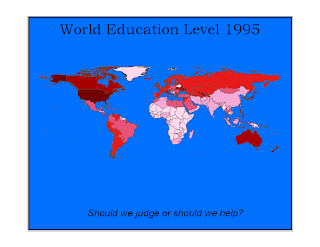

After a week of trying and failing, I realized that there was something wrong with the computer I was on. I never was able to access the information other students had because the files wouldn't open. Also, I was not able to select 100 cities, counties, etc. So, I tried a different computer, and lo and behold, it worked. I rushed it, so did not get strictly 100 places. I chose individual cities for the chloropleth because I feel that in addition to education level, the number of individual sites gives a greater impression of the impact and amount of education than a straight fill-in color. I added the country chloropleth map for comparison.
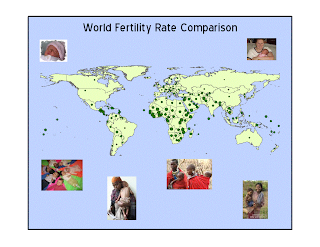
I like the small scale symbols on this map because the countries with the lowest fertility rates are surprisingly obvious.
 I felt like I needed a plain background for these maps because the various islands and symbols would get lost in a fancy background.
I felt like I needed a plain background for these maps because the various islands and symbols would get lost in a fancy background.Monday, February 23, 2009
Wednesday, February 18, 2009
A Day in the Life of Three UCLA Students
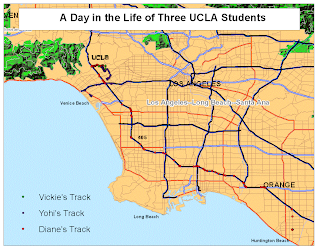 We started with this map, but found that it didn't look quite the way we wanted, so we moved on to the format below.
We started with this map, but found that it didn't look quite the way we wanted, so we moved on to the format below.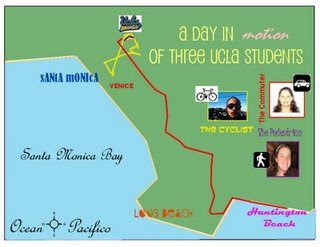

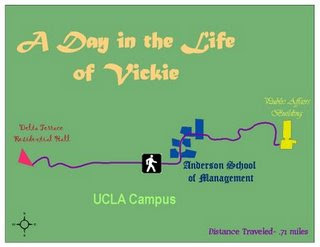
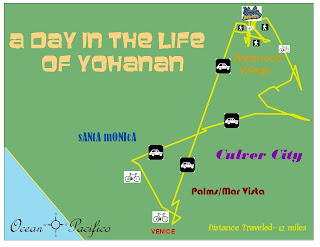
Twice a week, this is really all I do in a day:
Drive to school at 6:00 a.m., work here all day, then
drive home at 9:00p.m. I'm glad I like it here!
We made regular street maps, but then they looked like regular street maps with dots on them. This is interesting, simple, visually appealing, and gets the basic point across.
Monday, February 2, 2009
Graphic Design Black & White
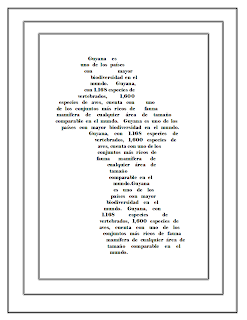
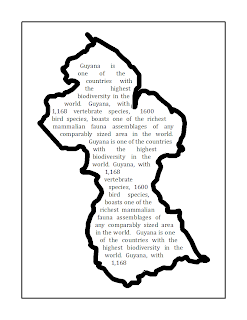 Some of the type and graphics look gray on the website, but if the pictures are enlarged, they do show up as black and white. That is really all I used.
Some of the type and graphics look gray on the website, but if the pictures are enlarged, they do show up as black and white. That is really all I used.

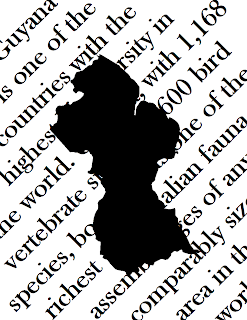
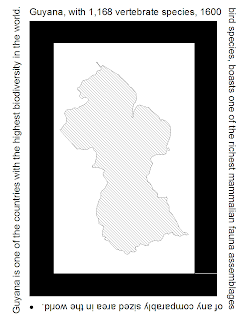

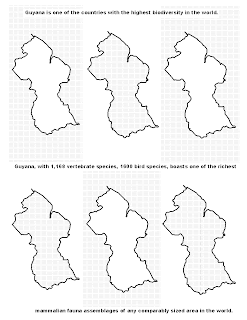
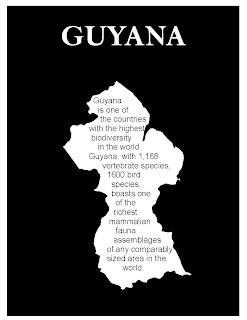
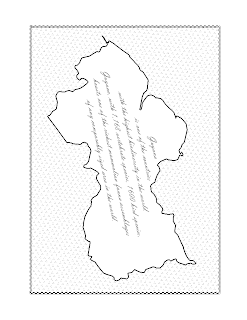
I tried to explore many different ways of filling in and framing Guyana. I worked on interest and balance, and most of the time thought about what would be pleasant to see in a travel advertisement. Some ideas were just interesting, but with three midterms and three other projects due, couldn't spend as much time as I would have liked.
Wednesday, January 28, 2009
Argentina Population Density
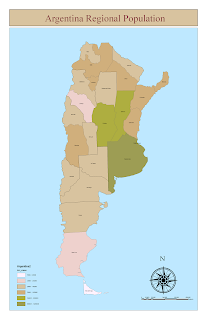 For my first map, I used a typical color distribution to show population density. This looks nice and displays the differences, but only the two extremes really stand out.
For my first map, I used a typical color distribution to show population density. This looks nice and displays the differences, but only the two extremes really stand out.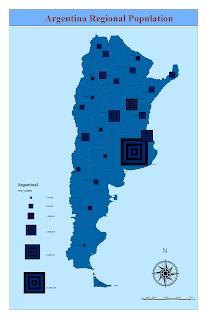 For this map, I chose a different approach for differentiation. I like how the distributions are distributed in such a way as to immediately tell the population size for each region, Buenas Aires having obviously the much greater numbers. The region lines did not show up as well as I thought.
For this map, I chose a different approach for differentiation. I like how the distributions are distributed in such a way as to immediately tell the population size for each region, Buenas Aires having obviously the much greater numbers. The region lines did not show up as well as I thought.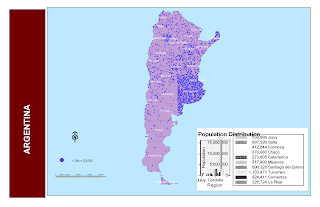 For this map, I wanted to show the population with a little different impact. I also made and inserted a graph. The original showed all the regions and looked very nice. However, when I finished and inserted it, only a few of the regions showed, and I could not change the appearance of the graph itself, such as size and placement of font, etc. I can see why extra items are better off made in another program and inserted.
For this map, I wanted to show the population with a little different impact. I also made and inserted a graph. The original showed all the regions and looked very nice. However, when I finished and inserted it, only a few of the regions showed, and I could not change the appearance of the graph itself, such as size and placement of font, etc. I can see why extra items are better off made in another program and inserted.Wednesday, January 21, 2009
Discrete" finite or fixed number of values)grades_'
continuous:" infinite number of values )te,perature_
nominal: categorical data (eye color; six, ethnicity)
ordinal: ordered categorical data, differences between values are not important (restaurant ratings; opinion polls)
interval data: ordered continuous data with a constant scale, but no natural zero (temperature)
differences can be calculated, but rtios are problematic.
ratio data: ordered continuous data with a constant scale and natural zero (geight, weight, age, length).
how they are measured matters in how they are mapped.
continuous:" infinite number of values )te,perature_
nominal: categorical data (eye color; six, ethnicity)
ordinal: ordered categorical data, differences between values are not important (restaurant ratings; opinion polls)
interval data: ordered continuous data with a constant scale, but no natural zero (temperature)
differences can be calculated, but rtios are problematic.
ratio data: ordered continuous data with a constant scale and natural zero (geight, weight, age, length).
how they are measured matters in how they are mapped.
Tuesday, January 20, 2009
2008 Election Maps

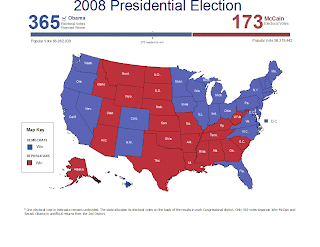
Here are my two election maps. I was amazed that I could make the first one like the original, with only one other ArcGIS assignment. It did take me three tries and many days. For the improved map, I wanted to add something, but remembered the rule of "one map, one purpose", so I did not. Nor did I change the map to become another map, but instead decided to improve the original map by adding black borders and darkening and enlarging the font to make it more legible. I removed the extraneous "Lead" information as it was distracting and confusing, and I removed the "undecided" information for the same reason. I believe the map is easier to read and understand now. I added a title so people would know what the map was about when it is looked at in the future. I enlarged and centered the states to take up the extra room left from the removal of the interactive things. It is centered and better looking.
Wednesday, January 14, 2009
First Assignment Due 1/14/09


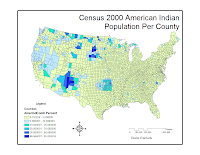
These maps show the distribution of Pacific Islander (Including Hawaiian) people alone and in combination with one or more races, people of Asian descent alone or in combination with one or more races, and populations of American Indian people alone or in combination with one or more races. These maps show populations greater than zero, ranked by percent of the specific population to the whole population of the county. It is interesting to note that there is a representative of all three nationalities in almost all counties in the United States. There appears to be at least one person of American Indian descent in every county in the continental United States. There are only a score or so counties that have no people of Asian descent. There are about 100 or so counties, mostly in the middle states, above, to the west of, and including Texas, that have no persons of Pacific Islander descent at all. On the West Coast, one large county in Washington seems to stand out as an anomaly of no Pacific Islander decendants at all among the generally higher percentage of these immigrants to the West Coast.
The trends for Pacific Islander and Asian immigrants seem to be to settle in the West Coast states generally, with many satellite groups within all states of the contiguous 48. There are some larger populations of Asian peoples in the business areas of the north east U.S. As a counter point, even though there seems to be a person with some type of American Indian descent in all 50 states, and all counties, the populations are really centralized to what would seem to be reservations or areas of specific population groups. It seems that there is not as much intermingling of American Indian people into the general population as there is for the other nationalities.
Saturday, January 10, 2009
Friday, January 9, 2009
Subscribe to:
Comments (Atom)




